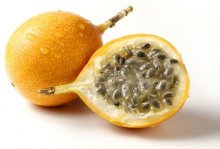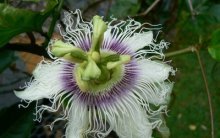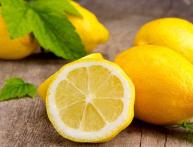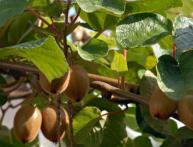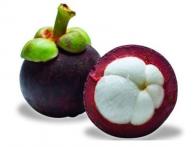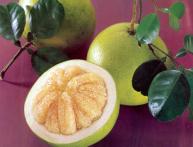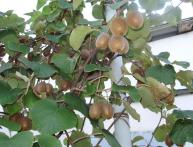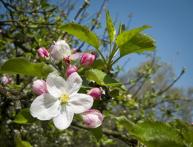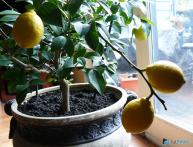Edible passionflower: heals, nourishes and pleases the eye
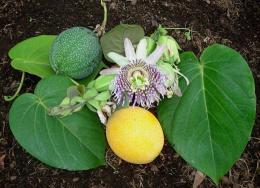
The unforgettable aroma of tea with the addition of passion fruit has captivated many admirers of this drink. This fruit is popularly called passion flower. And its scientific name is edible passionflower.
Content:
Passionflower in nature and at home
This plant is also known as grenadilla, lilikoi, pechenfruit, passion fruit, sweet cup, passion flower, cavalier's star and marquise. It came to us from South American countries, and is most actively grown in Sri Lanka, Australia, New Zealand and Israel. Under natural conditions, this plant is a perennial woody vine.
With its specific antennae, it clings and curls along walls and tree trunks. Climbing in this way, passionflower rises to a height of ten meters.
To protect itself from the rays of the scorching sun, the vine hides under the dense canopy of damp jungle vegetation. Hanging from the trees, it creates dense thickets. Out of 400 plant species The most popular is edible passionflower.
Description of the plant:
- Passion fruit vine is evergreen. Its leaves are placed alternately, the plate is divided into three dark green blades connected closer to the bottom, each about 20 centimeters long. The leaf edge is cut into small teeth.
- The passion fruit flower is single, about 3 centimeters in diameter. It consists of five sepals, five fleshy petals and five fragile stamens.
- The fruit is spherical, but oblong varieties are also found. The color can be yellow and even dark purple. Ripens several months after the flower is pollinated.
At home, passion fruit is grown as a hanging plant. The growth process of the vine is very fast. She needs a comfortable summer temperature of no higher than 26°C, otherwise the passionflower leaves will disappear. In autumn, the plant needs cool conditions - within 15°C.
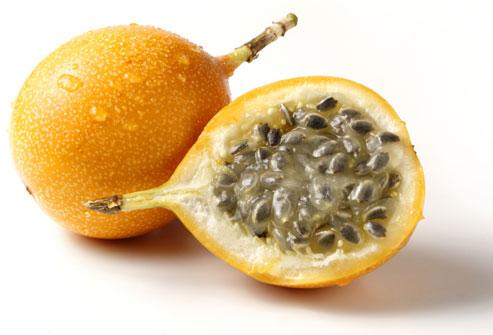
Maximum lighting is important for this vine. On southern windows it blooms profusely, but in the summer months edible passionflower needs shading. You need to water it abundantly at this time, but rarely in winter.
From spring to autumn passion fruit needs to be sprayed. But this is unacceptable when exposed to direct sunlight. Passionflower needs to be fed twice a month from spring to late summer. It should also be replanted every year.
Before the buds appear, the passion fruit should be cut to a third of the height of the stem before transplanting. It propagates in the spring by seeds, and in the summer by stem cuttings. Growing passionflower at home is a tireless and even enjoyable process.
Its exotic flowers look very impressive, filling the room with a light aroma, and the resulting fruits will bring truly heavenly pleasure!
Eating passion fruit
In the rainforests, both people and animals enjoy these amazing fruits. And in order to enjoy them outside the wild, edible passionflower has been made a house plant and is grown for its tasty fruits.
Breeders, creating new varieties of passion fruit, try to embody in them the most pleasant aroma, large size of fruits, enhance their juiciness, achieve a brighter color, rich sugar content with sourness in taste.They are also working on the abundance of vitamin C, optimal skin thickness, and resistance to pests and diseases.
In our country, passion fruit is found mainly as an additive to cake, fruit ice cream or compote. But more often than not, slices of it exotic fruit found in tea mixtures.
The tasty yellow jelly-like mass inside the fruit is suitable for consumption raw. But it is also mixed with sugar and diluted with water. This is how aromatic drinks, amber jam, delicious sherbet or amazing jelly are made.
Fruits are also included in puddings, curd mousses and cakes with fruit cream. Slices of the fruit are used to decorate salads, and the crumbs are used to create the effect of rain on the surface of cream, jelly or ice cream.
With sweet jam based on this fruit, they make amazing toasts, meat dishes, and include them in marinades for poultry and fish. Passionflower goes best with:
- almonds and hazelnuts
- apples
- pear and cinnamon
- rose
Like lime, which is combined with all dishes, edible passionflower makes dishes extraordinarily tasty. But when eating this fruit you need to be careful: passion fruit can also be inedible. Thus, a significant content of cyanide was found in azure passionflower. And in some other species there are many different toxic substances, although less toxic than in the azure one.
Healing properties of passionflower

In addition to its extraordinary sweet taste and aroma, passionflower has many beneficial pharmacological qualities. They are actively used for medical purposes. Passionflower fruits contain significant amounts of:
- vitamins A and C
- all B vitamins
- rare vitamin B3, so-called niacin
Indian tribes have long used the qualities of passion fruit.It is indispensable for them not only as a food product, but also as medicine. They use the leaves of this plant to calm and relieve pain. And the fruits heal the heart and get rid of cough.
Since passion fruit is found in passion fruit, which has a mild calming effect, in South American countries they try to give overly excited children juice from this fruit before bed.
Passion fruit leaves were also used to heal bruises, kneading them and placing them in place of severe pain. Passionflower was also used for colic, to treat intestinal disorders, and to cure dysentery. The plant helped overcome menstrual irregularities and insomnia.
The peel takes up half the weight of the fruit. But it is also useful due to its abundant content of ascorbic acid, proteins and carbohydrates. And the crushed peel waste is used as livestock feed and as fertilizer.
Edible passionflower can cope with neuralgia and eye problems. Even epileptic seizures stopped after a course of treatment with passion fruit. If you were overcome by muscle pain, you also took this fruit.
Passion fruit has been grown in European countries since the 17th century. Since then, its decoction has been valued as a sedative and tonic, actively used in modern medicine. According to the chemical composition, passion fruit is rich in glycosides, alkaloids and flavonoids.
Scientists were struck by the fact that the components of the fruit individually do not produce the effect that they can do as part of the plant. Passion fruit is especially valued for the calming effect produced by the flavonoid chrysin. And alkaloids relieve spasms and reduce blood pressure.
In addition to the well-known properties of passion fruit, research has also revealed its diuretic effect.And at the beginning of this millennium, passionflower leaves became the basis of an antitussive extract. Such plant properties Can only be compared to codeine.
More recently, scientists have discovered the enhancing effect of passionflower on potency. It also promotes fertilization. Passionflower is also used for medicinal purposes and as a food product.
Trying to understand the action of edible passionflower, scientists have been studying it for a very long time, and they continue to do so today. Over a century of study, all the properties of passion fruit that traditional medicine endowed it with have been confirmed. Therefore, in modern medicine it is recommended to take it as a sedative, antispasmodic and analgesic.
Watch an interesting video about blue passionflower, or passion fruit:
Interesting information about the vegetable garden

